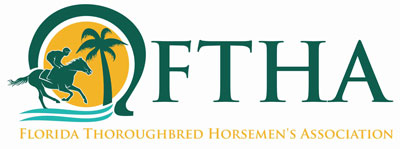December 5, 2012
Gulfstream Park announced today they will ease the hardship of horsemen staled at Calder Race Course by paying the stall rent of horses who participate at its meet during the month of December.
FHBPA’S Answers to Calder’s Stall Fee Q & A
QUESTION ONE: What prompted the introduction of stabling fees during the off-season?
Calder answered that pari-mutuel revenues have declined more than 40% in the last 6 years while other expenses have risen. But consider this, seven miles away at Gulfstream pari-mutuel revenues were up 6% over pre-construction Gulfstream in 2005 and up 11% over post-construction Gulfstream in 2009. Gulfstream advertises its racing program heavily, while Calder only advertises its casino. Calder’s biggest racing day was the Summit of Speed on which Calder spent no money advertising in print media or on television.
Further, if Calder has invested millions of dollars in capital improvements to the stable area, it is a well- kept secret to horsemen on Calder’s backside. The EPA did force Calder to spend about $1.3 million on its “impressive” manure removal system, but other than that, we have been unable to find the millions of dollars “invested” in backside capital improvements.
QUESTION TWO: Where will the horses go if their owners decide not to stable at Calder?
Calder answers that Palm Meadows charges $15 a day and the horsemen can go there if they want. Actually, the day rate at Palm Meadows (which is the most beautiful and well-equipped training center in North America) is only charged during the race meet. Along with that, every time a horse makes a start a month’s free stall rent is credited to the trainer’s account. From mid-October to December 1st the rent is FREE. Rent is also FREE the last four weeks of April after the meet closes.
By dropping this stall rent on us at this late date, Calder gave its horsemen no real options, since Gulfstream’s stall applications (including Palm Meadows) were due last week and Tampa’s are due on Monday, October 1. As for other private stabling facilities such as Payson Park, their stalls are already reserved by Northern horsemen.
QUESTION THREE: How do other racetracks manage stabling and training when they are not racing live?
Calder answers that the industry standard is for tracks to close their stable areas or charge rent. Then they go on to state that Calder is among the last tracks to make stalls available when not running live. Calder does not mention that the FHBPA has had a “no stall rent” clause in its contract for the last 15 years. Our contracts have always stated that Calder must remain open rent free for 10 weeks outside of its meet; a minimum of four weeks (that is all of December) after the meet and six weeks before the meet begins. Calder has once again chosen to violate the letter and the spirit of our historical purse contract. Along with that, they have chosen to destroy their future racing program in April when they will re-open with very few two-year olds ready to run.
QUESTION FOUR: With 1,800 stalls, will Calder collect enough in stabling fees to cover all the expenses of operating and maintaining the stable area and a training facility during the off-season?
Calder answers that they won’t recover their expenses and expects the occupancy rate to drop from 68% to “nearly 50%.” Somebody in management was overly optimistic to think that 50% of the stalls will be occupied this off-season. Very few Calder horsemen would be able to afford this stall rent. Also, with the evacuation of horses from Calder’s backside, there will be a similar evacuation of grooms and hot walkers who are currently paying $5 a day for their rooms. Those rooms, of course, actually are about the size of a stall with all the amenities one might find in a stall.
QUESTION SIX: Does this new fee conflict with any existing agreements or contracts with horsemen?
Calder says the current agreement “allows for Calder to close its stable area when there is no live racing.” As per the actual contract that both parties signed, that is simply untrue. We described earlier what our current contract says about being open during the non- racing season. The backside MUST be open rent-free for a minimum of four weeks after the meet closes and six weeks before the meet opens.
QUESTION SIX: Why doesn’t Calder use casino funds to subsidize horsemen’s stabling needs?
The FHBPA negotiated a 10-year slots contract with Calder, which included a provision requiring 35% of any future tax reduction to go to overnights. The horsemen also get 50% of net revenues from the poker room, but somehow Calder has had a hard time making a profit from poker, so very little has gone to purses. With the previously mentioned 40% decline in Calder’s pari-mutuel revenues, the strong slots negotiations by the FHBPA has made it possible to cover the loss in Calder handle, which declines every year. So, Calder purses have remained essentially the same over the last four years.
Oh, and by the way, Churchill Downs Incorporated (CDI) made a $65 million dollar profit last year, mostly from ADWs and slots. Too bad there was so little money left over for its racing product, which is the only reason they have ADWs and slots in the first place.
And, finally, Calder doesn’t “pay out” $30 million dollars a year to horsemen in purses. Purse money comes from a negotiated portion of the bets made on our horses. The casino only exists because we put on the races. Purse money isn’t “paid out” by Calder, it is EARNED by Calder horsemen and their horses. Calder is supposed to be a partner to the horsemen. Instead, we are being treated like serfs to feudal lords.
www.FHBPA.com
Visit our blog at www.FloridaHorsemen.com
Find us on Facebook at “Florida Horsemen’s Benevolent and Protective Association”
Twitter: @FloridaHorsemen
954.457.3516 | info@floridahorsemen.org



